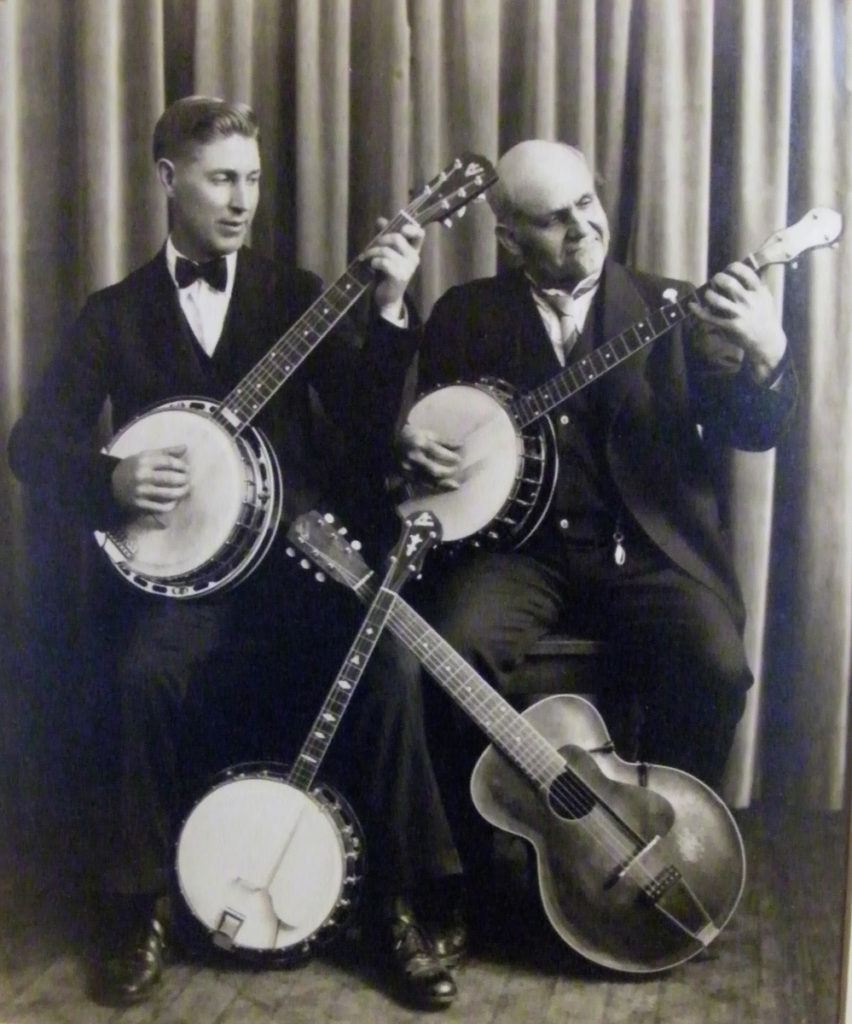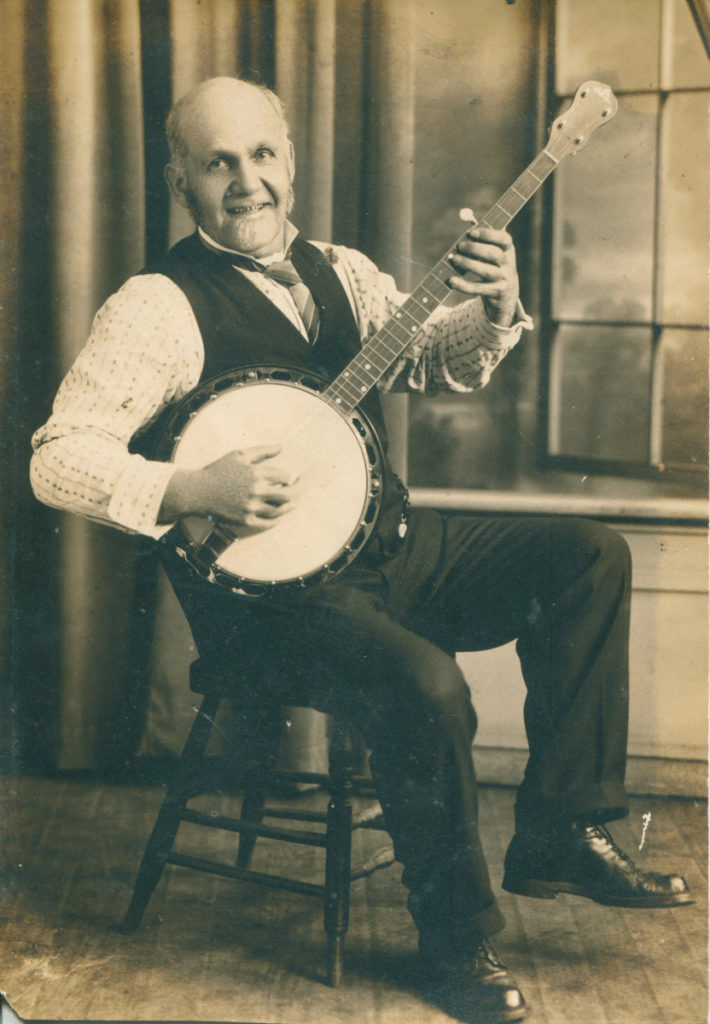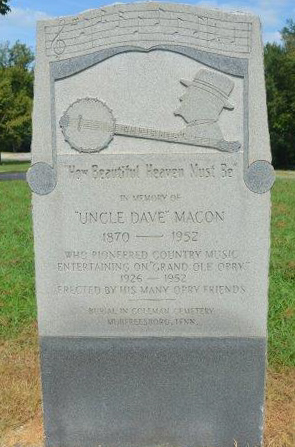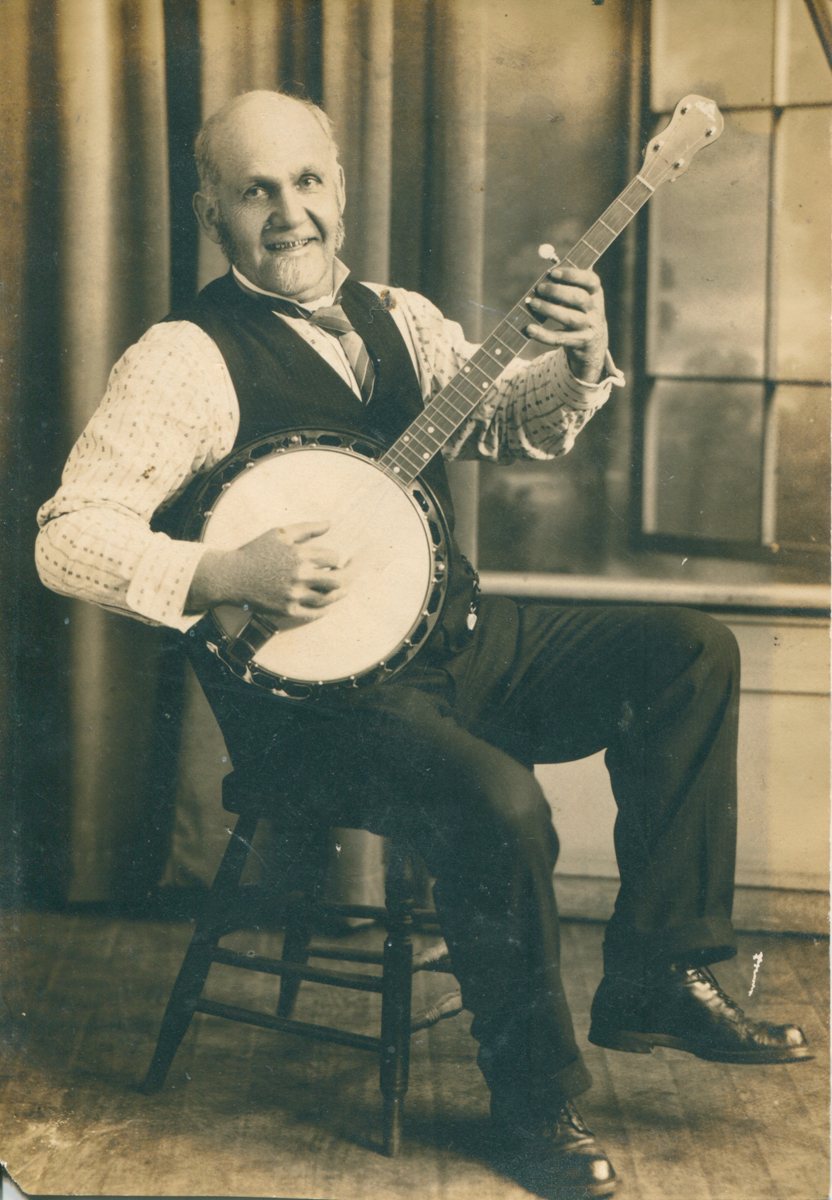“Instrument Interview” posts are a chance to sit down with the instruments of traditional, country, bluegrass, and roots music – from different types of instruments to specific ones related to artists, luthiers, and songwriters – and learn more about them. Ten questions are posed, and the instruments answer! Today we talk with Uncle Dave Macon’s banjo.
Who are you?
I am a Gibson 5-string banjo, Model RB-1. I was born in 1928 at the Gibson Company’s facility in Kalamazoo, Michigan. It was my good fortune to be the first banjo given to Uncle Dave Macon by Gibson as part of a national advertising campaign. I was made special, without a resonator and with a wooden dowling, all to make me lighter so Uncle Dave could better perform his “trick banjo playing,” as he called it. I stayed with Uncle Dave for nearly 25 years, until he passed away in 1952. Most other production RB-1s at the time were made for sale; in 1928 a Gibson banjo with case sold for $26.
Where did you first meet Uncle Dave?
I’ll never forget that day! In 1928 the folks at Gibson had hired Uncle Dave as a promoter for their national advertising campaign, and so a photo shoot was set up to help with the promotion. A Gibson sales representative took me to a photographer’s shop – Wagner Studios in Cullman, Alabama – and I met Uncle Dave there for the first time. I have to say, it was love at first sight for both of us. He looked at my fine craftsmanship with glee, and it was my pleasure to be in the hands of the most renowned and popular banjo player of the day, all the while knowing that I was headed for center stage at the Grand Ole Opry.

Were you his only banjo?
No, I wasn’t. And I want to share some private information that most people don’t know. Uncle Dave and his dear wife, Miss Tildy, raised seven sons. As part of compensation for his advertising work, Gibson agreed to provide Uncle Dave with other banjos, and before long, he had seven Gibson banjos in all. We were like a second family to Uncle Dave, and being the first he acquired, the other banjos looked up to me like an older brother. Not to be prideful, but Uncle Dave eventually gave away or set aside the first banjos with which he had started his career and used only us Gibsons. The Dixie Dewdrop truly believed the punch line of Gibson’s advertising campaign: “Only a Gibson is good enough.”
Is it true that Uncle Dave always performed using three banjos?
It sure is! He used three banjos so he could switch quickly from song to song without having to re-tune his instrument. The three banjos were tuned in the keys of C, F, and G. I was always set to the key of C.
What are your fondest memories of being with the Dixie Dewdrop?
No doubt, it was being part of his shows. It was fun, but Uncle Dave really made us work. Once he took to the stage, it was non-stop action. His picking style made it sound as though us Gibsons were singing right along with him, and we often felt we were the center of the show, even though we knew that was Uncle Dave’s rightful place. We had to twang, spin, and twirl throughout the entire show – without much rest! When we’d get overheated from all the frenetic playing, Uncle Dave would remove his big, black hat and fan us to cool us down, a stunt that always made the house roar. With the travel and all, it was hard work, but Uncle Dave really cared for us. Like I said, he treated his seven Gibson banjos like a second set of sons.
Uncle Dave didn’t begin his career as a professional entertainer until he was age 50. Did that help or hurt him?
It definitely helped him. By the time he turned 50, he was at the peak of his playing abilities. He had also learned so many other traditional songs that younger musicians just didn’t know. His age also gave him confidence in dealing with all the people we encountered. Uncle Dave was always honest and fair with folks, especially when it came to his financial dealings.

Were there any special, personal moments you’d like to share?
Well, most folks know that Uncle Dave fought alcoholism and depression for much of his life. What they don’t know is that when he began to recover from these episodes, he would call for a banjo. One of his Gibson banjos would hop into his lap, and he’d start to play and sing. Before long, that music would completely restore sobriety and lift the fog of depression. The cure for Dave Macon’s ailments didn’t come from a little box of pills or a medicine bottle; all of us Gibson banjos were his best therapy!
What happened to you after Uncle Dave passed away?
What a sad time that was for us! One of us was stolen from Uncle Dave’s house, even before the estate sale was conducted, and has not been seen since. However, Uncle Dave had left instructions for his Gibsons to be given to folks who he knew would take good care of us. His son Dorris, who had played with his father for nearly 25 years, knew Uncle Dave’s wishes and carried out those instructions. Our little Gibson family was broken up and given to various entertainers. I had a fortunate fate, being bequeathed to Roy Acuff, who really appreciated what I and Uncle Dave had done together. One of us went to Stringbean, another to Brother Oswald, another to June Carter, and yet another to Earl Scruggs. We still don’t know the fate of the seventh banjo. Uncle Dave honored us all in a special way. On his tombstone is inscribed the epitaph “The World’s Most Outstanding Banjoist.” I like to think that all of us Gibsons had a lot to do with making that tribute a reality.
And so where are you now?
I’m on public display at the rear of Ryman Auditorium in Nashville as part of the Roy Acuff Collection. I hang in a display case that also features a short history of the song “Rock About My Sara Jane,” one of Uncle Dave’s most popular tunes, which he learned while living in Nashville as a teenager. From my vantage point, I can still see the center stage of Ryman Auditorium, where Uncle Dave played and sang his last song ever on March 1, 1952, not long before he passed away.
I’ve heard you can also be seen somewhere else?
The second location where I can be seen is on Uncle Dave’s roadside monument located just east of Woodbury, Tennessee. It was placed there by other Opry stars in 1955 to honor Uncle Dave’s great status as the “Grand Ole Man of the Grand Ole Opry.” Near the top of the tall memorial, Uncle Dave is depicted in a fine, chiseled profile. I’m shown right below in full relief, 5-strings and all! It is an honor for me, and all the other Gibson banjos, to know that our name and reputation will always be remembered as part of Uncle Dave’s music and performance legacy.
*To learn more about Uncle Dave Macon, his banjos, and his life in music, join Michael Doubler in the museum’s Performance Theater on Sunday, November 4, 2018 at 1:00pm for a talk and signing of his new book Dixie Dewdrop: The Uncle Dave Macon Story. This program is free and open to the public.



